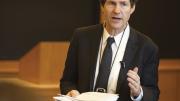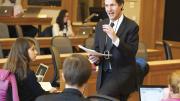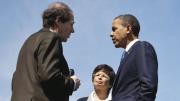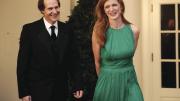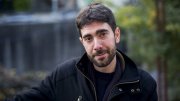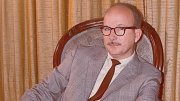Cass Sunstein ’75, J.D. ’78, has been regarded as one of the country’s most influential and adventurous legal scholars for a generation. His scholarly articles have been cited more often than those of any of his peers ever since he was a young professor. At 60, now Walmsley University Professor at Harvard Law School, he publishes significant books as often as many productive academics publish scholarly articles—three of them last year. In each, Sunstein comes across as a brainy and cheerful technocrat, practiced at thinking about the consequences of rules, regulations, and policies, with attention to the linkages between particular means and ends. Drawing on insights from cognitive psychology as well as behavioral economics, he is especially focused on mastering how people make significant choices that promote or undercut their own well-being and that of society, so government and other institutions can reinforce the good and correct for the bad in shaping policy.
The first book, Valuing Life: Humanizing the Regulatory State, answers a question about him posed by Eric Posner, a professor of law, a friend of Sunstein’s, and a former colleague at the University of Chicago: “What happens when the world’s leading academic expert on regulation is plunked into the real world of government?”
In “the cockpit of the regulatory state,” as Sunstein describes the White House Office of Information and Regulatory Affairs, which he led from 2009 to 2012, he oversaw the process of approving regulations for everything from food and financial services to healthcare and national security. As the law requires, he was also responsible for ensuring that a regulation’s benefits generally exceed its costs. By doing so, his office helped the Obama administration achieve net benefits of about $150 billion in its first term—more than double what the Bush and Clinton administrations achieved in theirs. He especially tried to humanize cost-benefit analysis, by focusing on the human consequences of regulations—including what can’t be quantified.
The second book, Why Nudge? The Politics of Libertarian Paternalism, is about the type of policy or rule that Sunstein is especially eager to see government and other institutions use regularly: nudging in one direction, with little or no cost to those who decline nudges and go their own way. Little he did in the White House involved nudges, but his job gave him the chance to see many areas of American life where they could make a large difference.
He developed the concept with Richard Thaler, a professor of behavioral science and economics at the University of Chicago. Sunstein defines nudges as “simple, low-cost, freedom-preserving approaches, drawing directly from behavioral economics, that promise to save money, to improve people’s health, and to lengthen their lives”—small pushes in the right direction, like a restaurant disclosing the calorie count of each dish so patrons are more likely to order healthy food, or a company setting up its 401(k) plan so employees are automatically enrolled in the savings program and must choose to opt out.
In recent decades, behavioral economists have shown that, out of impulse, impatience, or ignorance, people often make choices that are not the best or even good for them: we are not the rational self-interest maximizers that conventional economists have long assumed [see “The Marketplace of Perceptions,” March-April 2006]. In response, “choice architecture” (a term Sunstein and Thaler coined) refers to the design of environments in which people make choices—a school cafeteria, say—and to the reality that there’s no such thing as a neutral design. Whether the cafeteria puts apples or Fritos at the front of the line, the placement will affect which snack is more popular. In Sunstein’s view, the cafeteria ought to put apples first. Nobody is forced to take one: the nudge is “freedom-preserving” because a student can choose not to grab an apple.
The third book, Conspiracy Theories and Other Dangerous Ideas, was published to take advantage of his intellectual celebrity. In the run-up to the 2008 presidential election, The New York Times reported that Sunstein was one of the few friends Barack Obama made when both were teaching at the University of Chicago Law School in the 1990s: the friendship elevated Sunstein’s profile when Obama became president. His status as a policy luminary was confirmed by his marriage to Samantha Power, J.D. ’99, who is as close to being a real celebrity (read a profile of Power in the New Yorker) as a policy wonk can be. (“A Problem from Hell,” her Pulitzer Prize-winning 2002 bestseller, is a vivid polemic about U.S. government inaction in the face of genocides [see “An End to Evasion,” September-October 2002]. Obama, still in the Senate, hired her first as a foreign-policy aide and then as an adviser during the 2008 presidential campaign, where she and Sunstein met. She is now the U.S. permanent representative to the United Nations and a cabinet member. Sunstein introduced her at his confirmation hearing before the Senate as “my remarkable wife, brave Samantha Power….”)
The dust jacket of Conspiracy Theories quotes denunciations of Sunstein so extreme it’s hard to imagine what he could have said or done as a government official to trigger such vitriol. Glenn Beck, the conservative commentator, repeatedly called him “the most dangerous man in America”—“Sunstein wants to control you,” he declared, mistaking nudges for edicts of the nanny state: “He’s helping the government control you.”
Before he joined the government, Sunstein explains in this book, his job as an academic was to “say something novel or illuminating,” because today’s “wild academic speculation” could become tomorrow’s solution. Conspiracy Theories presents some of those speculations, using the alarums from Glenn Beck and others to draw a wider audience. The title essay, written in the wake of 9/11, is about the proliferation of conspiracy theories then (“49 percent of New York City residents believed that officials of the U.S. government ‘knew in advance that attacks were planned on or around September 11, 2001, and that they consciously failed to act’ ”) and why the theories spread. His purpose is “to shed light on the formation of political beliefs in general and on why some of those beliefs go wrong.”
Believers in conspiracy theories, Sunstein emphasizes, are often ill informed: they believe what they hear—and they hear only from people with extreme views. The scholar Russell Hardin named this problem “a crippled epistemology,” the kind of two-word moniker that Sunstein favors. People who move in and out of such groups make the problem worse. Those who leave tend to be skeptics: when they go, so does their moderating influence. Those who join and stay tend to become fanatics. When a theory attracts fanatics who act on their views, like terrorists, one possible governmental response could be what Sunstein calls “cognitive infiltration”: i.e., challenging the theory’s counterfactual foundations. Some civil libertarians ignored the “cognitive,” read “infiltration” literally, and went crazy denouncing the idea.
The dangerous ideas that most concern him are errors in thinking akin to crippled epistemology that lead to foolish or damaging behavior. They include misfearing, “when people are afraid of trivial risks and neglectful of serious ones,” so public funding is misallocated to combat the former instead of the latter, and the availability heuristic, a mental shortcut in thinking about risk that is influenced by heavily publicized events (floods, forest fires) so people worry about the wrong perils.
These concerns of Sunstein’s are weighty. They also seem narrow, leaving out of the picture the scope of the social purposes that they are designed to serve.
The second essay in Conspiracy Theories, “The Second Bill of Rights,” puts these current preoccupations in crucial perspective. A distillation of a book he published a decade ago subtitled FDR’s Unfinished Revolution and Why We Need It More Than Ever, it reveals Sunstein in a very different mood: strongly patriotic and adamantly visionary. He writes about “the only time a State of the Union address was also a fireside chat,” in January 1944, when President Franklin Delano Roosevelt, only 15 months before his death, spoke to the nation by radio from the White House. To Sunstein, the address “has a strong claim to being the greatest speech of the twentieth century.”
FDR used it to propose a Second Bill of Rights, to redress what he described as the Constitution’s inadequacies. He recommended rights to “a useful and remunerative job”; for “every businessman, large and small, to trade in an atmosphere of freedom from unfair competition and domination by monopolies”; to “a decent home”; to “adequate medical care”; to “adequate protection from the economic fears of old age, sickness, accident, and unemployment”; and to “a good education.” They “spell security,” the president said: “For unless there is security here at home, there cannot be lasting peace in the world.”
Roosevelt could make his proposal, Sunstein explains, because in that era “no one really opposes government intervention.” (The italics are his.) The address came only a few years after the end of the Great Depression, when it was all but universally accepted that “markets and wealth depend on government”—to prevent monopolies, promote economic growth, and preserve the system of free enterprise, but also to create “a floor below which human lives are not supposed to fall.”
To Roosevelt, the Second Bill of Rights was like the Declaration of Independence: “a statement of the fundamental aspirations of the United States,” in Sunstein’s words. The president argued not for a change in the Constitution, but for incorporating the rights he championed in “the nation’s deepest commitments.”
Sunstein’s enduring admiration for the proposed Second Bill of Rights helps bring into focus the overarching concern of his career as a legal scholar: to understand and explain how “the modern regulatory state” has changed America’s “constitutional democracy,” and how to reform the workings of government and society to promote “the central goals of the constitutional system—freedom and welfare.” The overarching concern of Sunstein’s legal scholarship is reforming the workings of government and society to promote “the central goals of the constitutional system—freedom and welfare.”
He has pursued these aims as a preeminent scholar in constitutional law, administrative law, and environmental law, and in related fields. He has also written about animal rights, gay rights, gun rights, the death penalty, feminist theory, labor law, securities regulation, and an almanac of other topics. The span from his microscopic focus on nudges to his panoramic interest in the constitutional system, with nudges carrying out the moral purposes of the Republic, helps explain why his standing in the legal world of ideas is, more or less, Olympian.
Penetrating the Impenetrable
Sunstein is tall and big-boned, with a large head, a prominent nose and chin, and a tonsure of longish brown hair. His public uniform is a dark suit, a white shirt, and a dark tie—old-fashioned, unstylish, and earnest, which he appears to be, yet isn’t. His eyes seem to brood when his face is at rest, but they amp way up when something charms him: it gives him the look of a troublemaker. That’s more likely to happen when he is tie-less. He is a major time-optimizer, so his default mode in e-mail is buoyant and brief, as in, “True!” His hands pivot the way a puppeteer’s do—in his case, to set ideas in motion.
In conversation and in his writing, Sunstein occasionally provides glimpses into his inner life. It seems to be animated by relish for work as much as play (with the two often indistinguishable), by an impatience to get on with it, and by an outsized competitive streak: about the last, his wife said cheekily to a writer for Vogue after a whiffle-ball game, “You can say Cass is psychotic, if you so choose.” One way he masks that is by using irony in all its guises, whatever he is engaged in. This has been so for a long time. During high school, according to The Harvard Crimson, Sunstein told a friend, “Too much play and too little work makes Cass a dull boy.”
As a Harvard senior concentrating in English, he chose to write his thesis about How It Is, an obscure novel by Samuel Beckett. The novel is short, punctuation-free, and bewildering. It begins: “how it was I quote before Pim with Pim after Pim how it is three parts I say it as I hear it” and, to the uninitiated reader, never gets any clearer. Sunstein said recently, “I liked Beckett because he seemed both hilariously funny and interested in the deep questions, like, What’s the meaning of life? Especially for an adolescent, that would be hard to resist.” From a distance of 40 years, that isn’t a bad summary of his old interest, but it is the recollection of someone who took a very different path from the one he was on then.
His thesis leaves a very different impression. It’s the well-written and well-researched work of someone who seriously considered going to graduate school in English and had the ability to do significant scholarship about literature, but decided not to because he worried that the life of a humanities scholar would be too passive.
His thesis adviser, Robert Kiely, now Loker professor of English emeritus, taught courses about the postmodern novel, among other subjects. He said recently that How It Is “was not a book that I liked or even understood,” but Sunstein was “a 20-year-old English major who was determined to write his thesis on Samuel Beckett’s most impenetrable book.” He was “persistent, engaging, and already very smart and good at argument.”
Kiely “realized pretty quickly that it was the sheer difficulty of How It Is that challenged Cass. He was not one to take on easy problems!” In the end, Kiely continued, “He very nearly succeeded in making this depressing book into a subject bordering on pleasure.” Sunstein graduated magna cum laude.
Kiely had such a high opinion of him that he reversed the custom of students expressing gratitude to teachers and acknowledged the debt he felt to Sunstein. In a book about the modern novel, he wrote that Sunstein (and another former student) represented “that combination of literary intelligence, moral commitment, and curiosity that have been a delight and refreshment to me as a teacher.”
Squash was Sunstein’s other obsession during his last year of college. He was a cerebral, gentlemanly, and very competitive player on a varsity team that was among the best in the country. He graduated in three years to move on to law school, so he had a year of eligibility left when he got there and kept playing for the varsity. The only match he lost that season (one of two he lost playing varsity squash) was against a superb Princeton player. But Harvard won the team match and, as a result, the national championship.
Sunstein’s law-school squash-playing solves a minor but longstanding mystery. He was on the winning team in the school’s 1977 Ames Moot Court Competition and again graduated magna cum laude (in the top 10 percent of his class), but didn’t make the Harvard Law Review. At the time, the primary way to make the review was being one of the top 20 students at the end of the first year. (A smaller number of students were picked in a writing competition, which Sunstein didn’t enter.) From the squash team’s perspective, according to David Fish, then assistant varsity squash coach, now head coach of men’s tennis, “It was truly remarkable that he was able to play on the varsity in his first year of HLS.” Each commitment was almost pre-emptively demanding.
A couple of years after leaving the law school, it dawned on Sunstein that he might want to become a law professor, but he wasn’t sure his credentials were good enough. (“Even if you were on the Law Review,” he brought up recently, “the chance that you’d actually get to teach didn’t seem to be high.”) But he was a beneficiary of “choice architecture”: he had a clerkship with Supreme Court Justice Thurgood Marshall—and top law schools interviewed any clerks who were interested in teaching at the Court, rather than at the big annual gathering of the Association of American Law Schools known as the “meat market.” That was helpful even to a modest outlier, as Sunstein was.
At the time, the University of Chicago was eager to balance its top-heavy law faculty with some junior members and to take some risks in its hiring. The school’s then-new dean, Gerhard Casper (later president of Stanford) recently said that Sunstein “impressed me with his subtlety and his wide range of intellectual interests, especially in public law, which was even then his great love.” He got the job and taught at Chicago for 27 years until moving to Harvard in 2008.
Sunstein has made a law-review credential seem less essential for would-be legal scholars. He has made squash seem indispensable for him—and has written about that. Last fall, he got the chance to play in a professional tournament in Washington, D.C. In a column he wrote about this caper for Bloomberg View, he struck a genial, self-deprecating tone about his loss of the match, by 3 games to 1, to a 20-year-old Pakistani pro named Mubarak Mohsin:
It is said that sheer randomness would enable a monkey, spending enough time on a keyboard, to at some point write the works of Shakespeare. In the first game, sheer randomness (undoubtedly accompanied by some bemusement on Mohsin’s part) enabled this particular monkey to grab an improbable win. But Mohsin had me running the whole time, and my legs really didn’t enjoy that. As Shakespeare would say, “When sorrows come, they come not single spies, /But in battalions.”
No Cant, No Pretentiousness— and a Focus on Law’s Impact
The squash column was one of Sunstein’s regular opinion pieces for Bloomberg—in his words, “low-cost” pieces that take little time to write and reach a wide audience. He recently wrote an op-ed in a different mood for The Chicago Tribune called “A Treasure-Trove Beyond Words.” Describing the Seminary Co-op Bookstore in Hyde Park, near the University of Chicago, he wrote: “More than any place I have ever been, it settles and quiets the mind.”
The piece contains a batch of clues about Sunstein’s passions. The books he mentions finding on the store’s Front Table, for “the newest and the best books,” are by authors he reveres: “On one day there was John Rawls’ Political Liberalism (just out!), and on another there was Amartya Sen’s Development As Freedom, and on another, A.S. Byatt’s Possession”—his favorite novel, a tour de force of plot twists that, Beckett-like, calls into question the concept of the “self.” More importantly, in describing the “gentleness of the store—its humility, its civility, its seriousness, its importance without self-importance, its absence of self-display, even its calm air”—he underscores his love of books, as an author keen to write some that are “full of life-altering surprises.”
Sunstein has been a writer since he was old enough to realize it. A close friend told The Harvard Crimson that in high school, Sunstein “had this weird thing where he’d be hunched over the typewriter kind of like Glenn Gould over the piano.” In college, he wrote for The Harvard Lampoon. Novelist Kurt Andersen ’76, host of the public radio program Studio 360 and a fellow Lampoon member, described him as “a dry and funny writer,” with “a kind of rigor in his work not true of everybody then or now.”
Sunstein’s models are writers with original ideas who aren’t household names. At the top of his list is Albert O. Hirschman, LL.D. ’02, a German immigrant to the United States who was an economist and, in Sunstein’s words, “an anti-utopian reformer” who ended up at the Institute for Advanced Study, in Princeton, New Jersey. He wrote four idiosyncratic books. The most important, The Rhetoric of Reaction, is about standard objections to proposals for reform and why the objections are usually wrong. Hirschman, Sunstein wrote in The New York Review of Books, was “delighted by paradoxes, unintended consequences (especially good ones), the telling detail, inventories of actual practices (rather than big theories), surprises, and improvisation.”
Wayne Booth, an eminent scholar of rhetoric and longtime member of the Chicago faculty who died in 2005, is another Sunstein model. “One of Booth’s ideas,” he said, “is that writers have ‘implied authors’ that are not necessarily consistent with their real personality” yet define the kind of company a reader will find in a book. He went on, “The writer of, let’s say, Wayne Booth’s The Company We Keep—I really like that person. He has a kind of wit and civility and decency and absence of sanctimony, a kind of appealing earnestness.”
In helping him refine his own implied author, other “tremendous influences” are: Sen, LL.D. ’00, the Nobel laureate in economics and Lamont University Professor, for “his combination of rigor and moral commitment” (“the great Sen!” Sunstein calls him); Richard Posner, LL.B. ’62, the highly respected federal judge, hyperprolific author, and outstanding legal scholar, “as one of the five or three best practitioners of pragmatism in the past 50 years” who writes with “no cant, no pretentiousness, and an acute interest in the human consequences of law”; and his coauthor, Richard Thaler, the pathbreaking behavioral economist: “If you look at his academic articles and his very few books, he tends not to hit singles and doubles, he likes to hit home runs, and that’s just not my style. I have itchier fingers than you can have if you’re only looking for home runs.”
Those fingers have made Sunstein the most prolific legal scholar of his generation as well as one of the most influential: 28 books to date plus 15 books coauthored with others, around 500 scholarly articles, and hundreds of other journalistic articles for The New York Review of Books, The New York Times, The New Republic, The American Prospect, Bloomberg View, and many other outlets. Wiser: Getting Beyond Groupthink to Make Groups Smarter was just published, coauthored with Reid Hastie, a Chicago professor of behavioral science. Later this year, Constitutional Personae will be published. To the common categories of politics and methods of interpretation for typing judges, he adds the personae of Heroes, Soldiers, Burkeans, and Mutes. Both conservatives and liberals can be any of them. The role they choose depends on how they think a case should come out (Sunstein writes: “The right Persona depends on the plot of the play.”).
Sharon Jacobs, J.D. ’09, is a professor at the University of Colorado Law School who, like Sunstein, writes in the fields of administrative and environmental law. She took a law-school seminar co-taught by Sunstein and views him as a master from the angle of a junior scholar. She is also a conservatory-trained musician. She compares him to his contemporary, the great cellist Yo-Yo Ma ’76, D.Mus. ’91 [see “Yo-Yo Ma’s Journeys,” March-April 2000]. While continuing to concentrate on playing classical music, his first love and most important repertoire, Ma has ventured into tango, country, jazz, Central Asian ethnic music, and other far-flung forms. Both of them, Jacobs said, “continue to experiment, and they bring back to the core of their work insights gained from other fields. Each behaves as though he is nowhere near the pinnacle of his career.”
Taking on John Stuart Mill
Sunstein’s account of his time in government is largely upbeat. He left some others with a less favorable impression. Bruce Ackerman ’63, a Yale professor and a longtime admirer and friend of Sunstein’s, said recently, “He has become a liberal technocrat, concerned about the interests of consumers rather than citizens. I’m all for liberal technocrats—we need liberal technocrats—but I would like to see him take up the cause of citizens again.”
The sharpest criticism has come from Lisa Heinzerling, a professor of law at Georgetown University, who worked for the Environmental Protection Agency during the Obama administration’s first two years and represented the agency in its dealings with the Office of Information and Regulatory Affairs. Last year, she basically accused Sunstein’s office of flouting the law, set out in federal statutes and executive orders, that specifies what the office can and cannot do in its assessment of regulations proposed by agencies. She also excoriated the office for operating on its own unreliable timetable, with “no meaningful deadlines” in “an utterly opaque” process.
Heinzerling’s description squares with news and other accounts, in particular a report for the Administrative Conference of the United States, an independent federal agency with the mission of improving regulation. The report documented that reviews by Sunstein’s office of proposed federal rules “took longer in 2011 and 2012 because of concerns about the agencies issuing costly or controversial rules prior to the November 2012 election.”
From 1994 to 2011, reviews of agency rules took an average of 50 days. In 2012, the average increased to 79 days and in the first half of 2013, to 140 days. The big reason for the delays, the conference report said, was “concerns by some in the Executive Office of the President (EOP) about the issuance of potentially costly or otherwise controversial rules during an election year.” There was a list of other reasons as well, but the report chose not to recommend “a strict time limit on the length” of reviews by the regulatory affairs office.
Sunstein has a policy against answering any questions about his time in government, so he declined to be interviewed for the conference report or to comment on it. That is what he described as “one of the many products of my years in Washington,” about which he can be prickly and self-protective to avoid repeating some “pretty ugly” experiences. About Heinzerling’s criticisms, he said, “She thinks it’s objectionable that the Executive Office of the President has a lot of deliberation about what to do with rules, and the content of the deliberation is not itself public. And I think that’s okay, like if there’s deliberation about a war or about a budget—internal discussions don’t go public, and that’s okay.”
The main impression Sunstein gives about conflicts like these is that he would much rather avoid them. He doesn’t like confrontation. He doesn’t like being attacked and, though he sometimes does it, he doesn’t like attacking. He would rather think about how to improve the design of government, and to test a proposal for reform against challenges to it on the basis of fundamental values, than rehash how well he did as an administrator of the current design.
His current preoccupation is the ethics of choice architecture, because—as interest in behavioral economics and nudges has grown in Europe especially—critics he takes seriously have raised questions he is eager to answer. In a PowerPoint presentation he gave in Berlin in December, one slide read:
Third Problem? Dignity
Problem of humiliation or disrespect
Is a GPS humiliating? Is a warning? A reminder?
Default rules vs. active choosing
Choice-requiring paternalism
But true: learning can be important
And risk of error on part of choice architect
This is the slide of a man in the middle of solving an intricate puzzle—as he wrote recently in a primer on nudges, to “make life simpler, safer, or easier for people to navigate.” He has a sense of urgency about the project (“The lives we save may be our own”) and a sense of mission (“Real transformations require a degree of consensus”). What matters now is how to locate the nudge idea in the thinking of the worldly philosophers, such as John Stuart Mill and the chief principle he articulated in On Liberty.
“In his great and inspiring essay,” Sunstein writes in Why Nudge? “Mill insisted that as a rule, government may not legitimately coerce people if its goal is to protect them from themselves”—usually called the harm principle. Sunstein shows that some of Mill’s most important justifications for the principle are wrong. One is that “individuals are in the best position to know what’s good for them.” Since Mill’s time, Sunstein writes, “we have learned a great deal that he did not know and could not know, especially about human error,” which is “in grave tension” with that principle.
The nudge idea is about simplifying and improving the market as well as government—in the United States and other societies. But his aims with nudging are the same as his longtime aims for American governance: to preserve individual freedom and strengthen the welfare of society.
What Matters in Law—and Governance
For the moment, Sunstein isn’t concerned about explaining where this project fits in his life’s work, but he went a long way toward doing that in his first book, published 25 years ago. After the Rights Revolution: Reconceiving the Regulatory State laid out the project he has worked on steadily for the past generation. He was 35 when the book came out and already held a distinguished chair in jurisprudence at Chicago.
Understanding “the rise of social and economic regulation,” he said, was his way of understanding contemporary “American law and government.” He wrote, “Modern regulation has profoundly affected constitutional democracy, by renovating the original commitments to checks and balances, federalism, and individual rights.” A decade and a half later, at Harvard and a number of other law schools, legal education changed dramatically to reflect this insight by putting courses about regulation at the center of the curriculum.
Between the New Deal, starting in the early 1930s, and when Sunstein became a law professor, in the early ’80s, he wrote, Congress created regulatory programs that covered relations between employers and employees, the safety of the workplace, the reliability of consumer products, the fairness of the market, the quality of the air, water, and other elements of the environment, the survival of endangered species, freedom from racial and other kinds of discrimination, and many other aspects of national life. In the decade before the New Deal, Congress passed 15 regulatory statutes. In the 1930s, that total tripled to 45. In the 1970s, it almost tripled again, to 120.
Sunstein saw this transformation as a product of “the liberal republicanism of American constitutional thought,” which views the political process “as a deliberative effort to promote the common good.” In the conception of republicanism designed by James Madison and reflected in the Constitution, he wrote, “the system of checks and balances provided a serious obstacle to national regulation.” As a result, “the vast majority of regulatory functions were undertaken by the common law courts” in the states, in lawsuits about contract, property, and tort (wrongful acts) disputes, public as well as private.
New Deal regulation rested on the conviction that the common-law system “reflected anachronistic, inefficient, and unjust principles of laissez-faire” and was inadequate “because it was economically disastrous, insulated established property rights from democratic control, failed to protect the disadvantaged, and disabled the states and the national government from revitalizing or stabilizing the economy.”
To address the crisis of the Great Depression, the New Deal transformed the system of checks and balances by increasing the power of the president, reducing the clout of the federal judiciary, and increasing the size of the national bureaucracy so that its power rivaled that of Congress. The New Deal transformed the system of federalism by transferring power from the states to the federal government. It redefined individual rights, from “rights to be free from government intrusion” to “government protection against the multiple hazards of industrialized society.” The result was “a dramatic change in the fabric of the national government….”
The administrative agencies of FDR’s era “often combined the traditionally separated powers of legislation, adjudication, and execution” and “often were given broad policymaking authority by Congress.” Some agencies, like the Works Progress Administration and the Civilian Conservation Corps, provided employment. Some helped stabilize the economy by creating risk pools that reduced the exposure of any individual or farmer, for example, or provided safety nets for the vulnerable, like the Federal Deposit Insurance Corporation and the Social Security Administration. Some regulated critical parts of the economy, like the National Labor Relations Act and the Securities and Exchange Act.
In the 1960s and ’70s, the president and Congress built on this foundation, enacting regulations to combat discrimination, protect the environment, and accomplish many other goals. In the 20 or so years from 1958 to 1979, for example, Sunstein listed 27 new federal statutes addressing environmental problems alone, including landmark laws like the Clean Air Act, the National Environmental Policy Act, and the Clean Water Act. He listed 11 addressing only occupational safety, such as the Black Lung Benefit Act. In general, the goals of these regulations were to reduce inequality and manage major risks for individuals and society.
Sunstein wrote After the Rights Revolution to bring regulation into the heart of conversation about what matters in law. But he also wanted to explain how “modern political science and public law” had generally failed in their dealings with modern regulations, treating the many different kinds as “an undifferentiated mass” or “as a crazy-quilt of unprincipled ad hoc repudiations” of the laissez-faire approach that prevailed before the New Deal. Regulation had become such a huge part of the federal government that not reckoning properly with regulation meant not dealing squarely with the nature of modern constitutional governance.
In the decade after that path-making book, Sunstein filled out his view of that governance. A central part of his argument is that debate about the Constitution’s meaning should expand to legislative, regulatory, and other democratic bodies, because “court-centeredness is a continuing problem for constitutional thought in the United States. It has helped to weaken the sense of responsibility of other officials and indeed ordinary citizens….”
He argued that the justices of the Supreme Court should resolve questions before them as narrowly as possible, to encourage elected officials to deliberate on divisive issues and test their answers before the voters. He called this approach “judicial minimalism” and wrote that, with this philosophy of leaving “fundamental issues undecided” in cases dealing with questions “on which the nation is currently in moral flux”—like the right to die and discrimination based on sex and sexual orientation—the Court would promote this country’s “highest aspirations without pre-empting democratic processes.” It would energize American democracy by making it more deliberative. He argued that the justices of the Supreme Court should resolve questions before them as narrowly as possible, leaving “fundamental issues undecided,” to energize American democracy by making it more deliberative.
“Democracy’s constitution is not tradition’s constitution,” he wrote. “A central purpose of a constitution, and of a deliberative democracy, is to subject longstanding practices to critical scrutiny.”
As he does.
